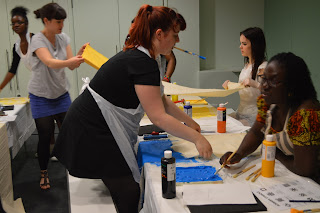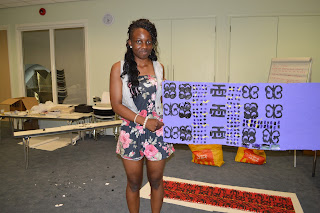Seiwa showed us some fabric and some of the stamps, which are carved from gourd (a bit like a butternut squash!). The Youth Advisors made their own non-vegetable stamps from foam!
 |
| Seiwa showing the Youth Advisors the fabric we would be recreating |
 |
| Isobel, Jennifer, Nicole and Adrian sharing the meaning of their names |
 |
| Adinkra fabric and some of Seiwa's artwork |
Adinkra is thought to originate in the Ivory Coast, Africa, and is named after a king 200 years ago. Adinkra cloths were traditionally only worn by royalty and spiritual leaders for funerals and other very special occasions. They are now worn by anyone, stylishly wrapped around women or men on any special occasion. In the past they were hand printed on red, dark brown or black hand-woven cotton fabric depending on the occasion and the wearer's role; nowadays they are frequently mass-produced on brighter coloured fabrics. There are hundreds of symbols and each one is based on a proverb and they will reflect the person that wears the cloth, or the person they are commemorating. Adinkra means to bid farewell in Ashanti and will often be worn at funerals. The colours are just as important as the symbols, and you can choose the background colour of your fabric depending on the meaning you want it to have. The symbols, however, are always black. Traditionally the symbols are laid out in a grid design with brightly coloured stitching inbetween, which we are going to do with paint today. The stamps are traditionally carved from gourd, like a pumpkin
We went through pictures of Adinkra symbols to choose three with an important and personal meaning, not just ones that looked interesting.
Amy and Isobel choosing their symbols
Seiwa helping the Youth Advisors choose
Tina, Piarve and Bethanie choosing their symbols
After lunch, the Youth Advisors painted the background of their fabric. Each colour had a meaning, such as white for purity, yellow for chicken fat which represented wealth, and purple for royalty.
Jennifer and Amy choosing their colours
Bethanie cutting out her stamp
Seiwa advising
Isobel's finished stamp. This one is 'OSRAM NE NSOROMMA ' and means love, faithfulness and harmony
Laura helping Adrian, Isobel and Amy
Tina tracing her design
Bethanie getting ready to print!
Bethanie's first symbol is HWE MU DUA, which means always striving for the best
Amy's design taking shape
Some original stamps made from gourd
Isobel's finished work, with Charlotte helping to hold it
Adrian's final work
Piarve's final work
Tina's final work
Next time we meet, the Youth Advisors will produce more fabric!



























No comments:
Post a Comment